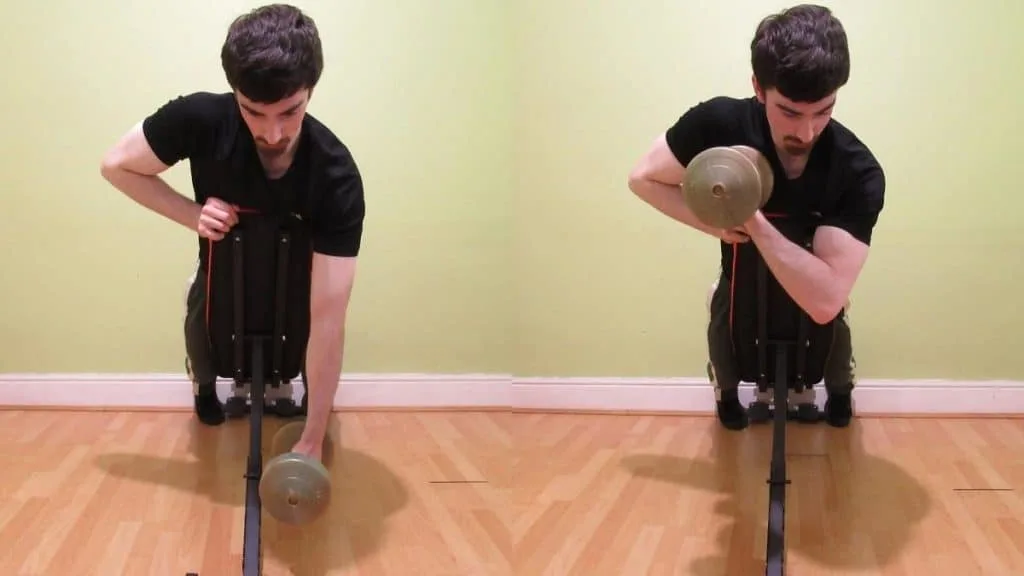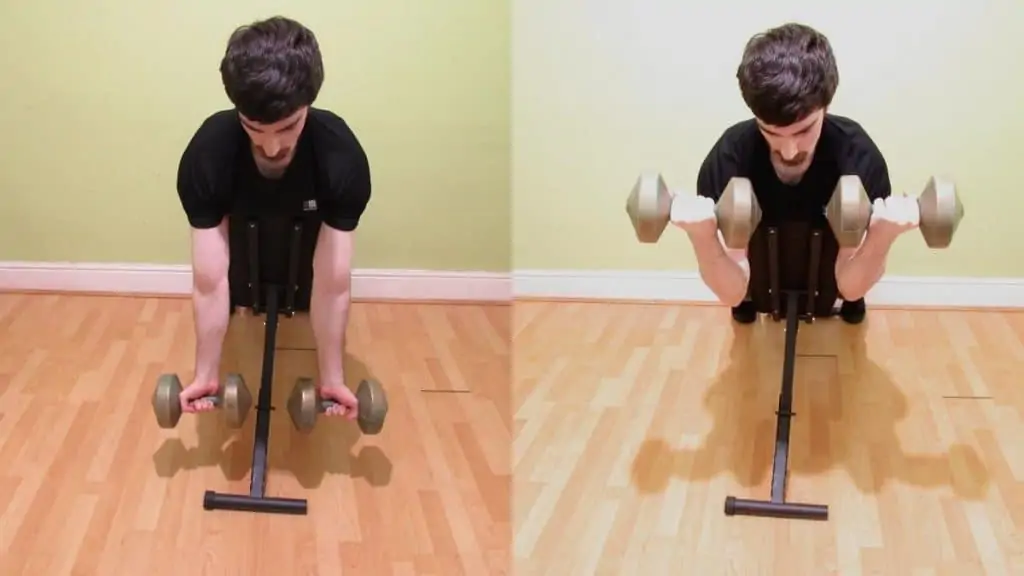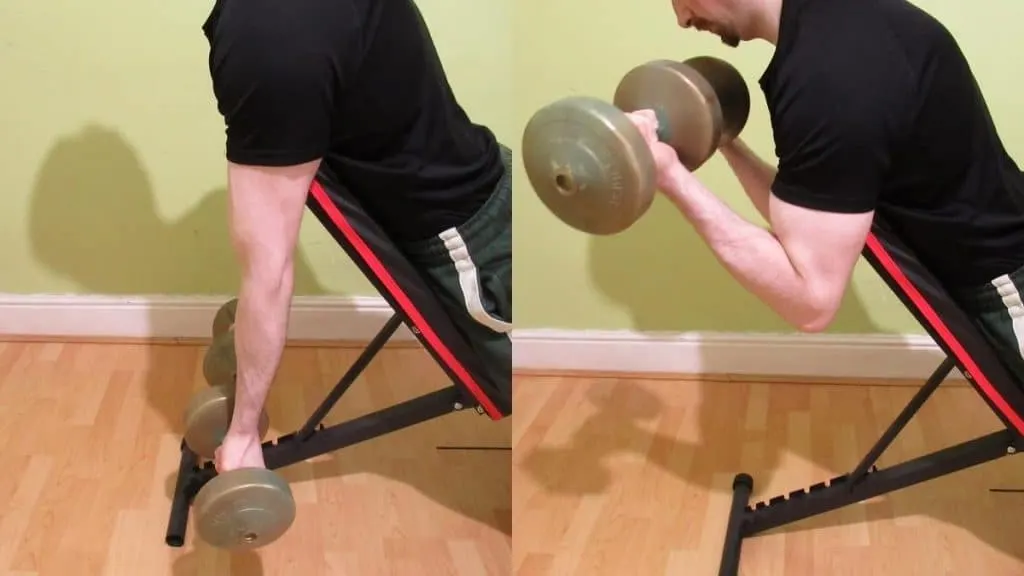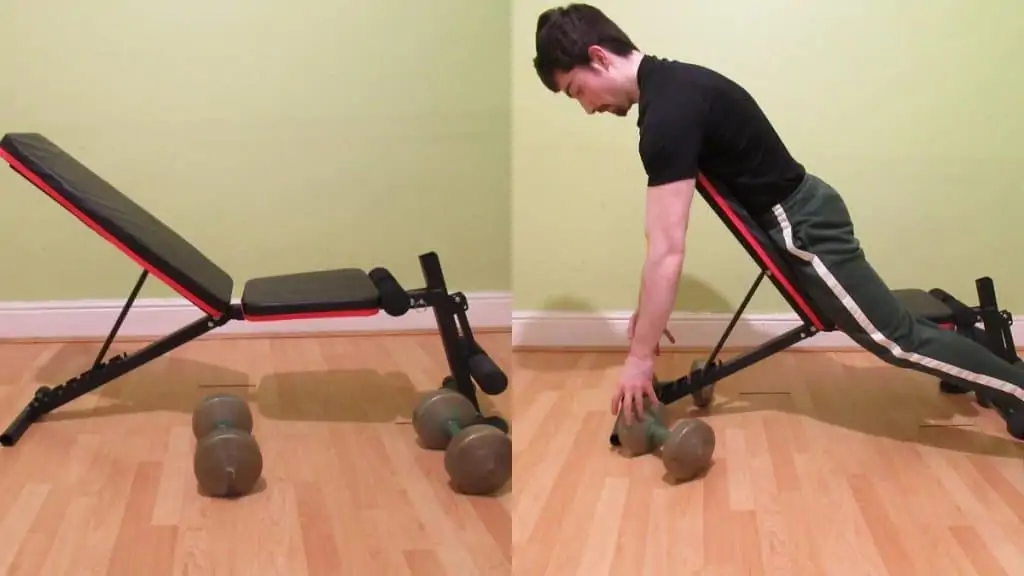The decline dumbbell curl is a deceptively effective exercise for building the biceps brachii. Although you have to lift lighter on this movement than on traditional weight lifting curls, decline curls really pump up your biceps and, because you’re lifting dumbbells, drastically reduce your chance of developing muscular imbalances.
Related Exercise: Decline dumbbell hammer curls
Decline dumbbell curl exercise details
- Main Muscles: Biceps brachii
- Secondary Muscles: Brachialis, brachioradialis, forearm flexors
- Exercise Type: Strength
- Exercise Mechanics: Isolation
- Difficulty Level: Beginner
- Equipment Needed: Dumbbells, weight bench
How to do decline curls
- Place two moderately light dumbbells at the backrest end of a weight bench.
- Set the back pad of the bench to between 45 and 60 degrees.
- Sit on the bench with your chest pressed against the backrest.
- Reach down and grab the dumbbells with a supinated grip.
- Let your arms hang so that your elbows are extended.
- Curl the weights toward your shoulders while keeping your elbows still.
- Keep lifting until the undersides of your forearms make firm contact with your biceps.
- Hold the contraction for a moment.
- Lower the weights under control until your elbows are one against extended.
- Repeat for 3-5 sets of 8-15 reps.
Decline bicep curl pros and cons
Decline bicep curls, as the name suggests, work your arms from a unique angle. This positioning definitely has its pros, but there are also some cons that you need to watch out for as well.
Pro: Great biceps pump

Just about every weight lifter loves the feeling of blood rushing through their biceps, a sensation that’s otherwise known as the pump. [1]
But getting a great pump doesn’t just involve doing endless sets of buddy curls. You need to be smart about your exercise selection if you want to maximize your pump.
Specifically, you want to do exercises like decline curls, which train the biceps in a highly contracted, shortened muscle position. After all, it’s repeated muscle contractions that actually create the pump in the first place. So any exercise that’s hardest in the contracted phase of the rep—the decline dumbbell curl is a prime example of this—is going to produce a powerful muscle pump.
Make sure to squeeze your biceps as hard as you can on every rep. Since there’s not much tension in the bottom part of the lifting motion when your elbows are close to full extension, it’s imperative that you take advantage of this movement’s most challenging phase, which is to say, when your biceps are nearing their maximally contracted state.
Pro: Builds symmetrical biceps

While exercises like the undeniably functional inverted rack curl can certainly build muscle, bilateral movements like this aren’t necessarily the best at building symmetrical biceps because your stronger arm can often dominate the exercise.
The decline curl, on the other hand, by the mere fact that it makes use of dumbbells means that it’s the perfect movement for making your biceps look more proportional. Since you have to lift each weight independently, your more muscular arm can’t help your weaker arm, which in turn means that both of your biceps will receive roughly equal stimulation.
This is especially beneficial if you’re a bodybuilder or if you train for aesthetics because symmetry is almost as important as size for sculpting a well-balanced physique.
So if you currently have bicep muscular imbalances or want to prevent them from occurring in the future, then it’s a good idea to switch out bilateral exercises for movements like decline dumbbell curls so that you can encourage your muscles to grow in proportion.
Con: Can feel uncomfortable

So far so good. Decline curls tick all the bicep building boxes. What’s not to like?
Two things, actually.
To perform the decline dumbbell curl correctly, you have to press your chest against the backrest of the bench. This is widely known to cause sternum discomfort for many lifters because you’re putting a significant amount of pressure on your chest area by bracing it against the bench. [2]
So if you feel any discomfort whatsoever, then it’s recommended to switch the exercise out for something else. After all, the problem is only going to get worse as you gain strength because the dumbbells are effectively trying to pull you through the bench, and so your chest has to bear the brunt of the load.
Con: Requires a bench

Since more and more former gym-goers are ditching their memberships to train at home these days, performing exercises that require extra equipment isn’t always feasible.
Sure, adjustable benches aren’t the most complex or expensive piece of equipment, but some weight lifting enthusiasts simply don’t have the space for bulky gym equipment.
Plus, even if you go to a gym, it’s not always possible to get a bench at peak times. And even then, you have to hope and pray that someone doesn’t take it while you go and fetch your weights.
Therefore, sticking to exercises that require a pair of weights and nothing more, such as the decline bicep curl, might be a better option if you’re short on equipment or train in a busy gym.
In conclusion

The decline dumbbell curl really pumps up your biceps, that’s for sure. Yet, this underrated exercise also helps to develop proportional biceps because by using dumbbells, you can ensure that both of your arms are getting equal work, which in turn helps your upper body to look more balanced.
If you don’t have a bench to do a decline dumbbell curl the traditional way, then you can actually mimic the movement by bending over at the waist slightly, letting your arms hang forward, and then curling the weights as you normally would. This variation is also useful if the regular version puts too much pressure on your sternum.
References
- How The Pump Powers Muscle Growth: Break Through With Benefits Of NO! (2019, January 25). Bodybuilding.Com. https://www.bodybuilding.com/fun/the_pump_builds_muscle.htm
- NHS website. (2020, August 11). Costochondritis. Nhs.Uk. https://www.nhs.uk/conditions/costochondritis/

